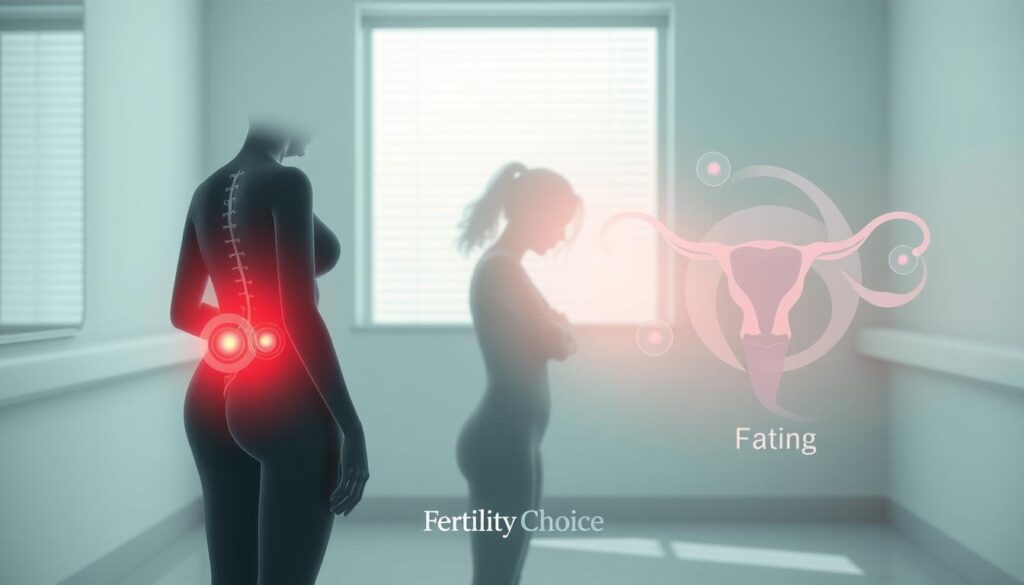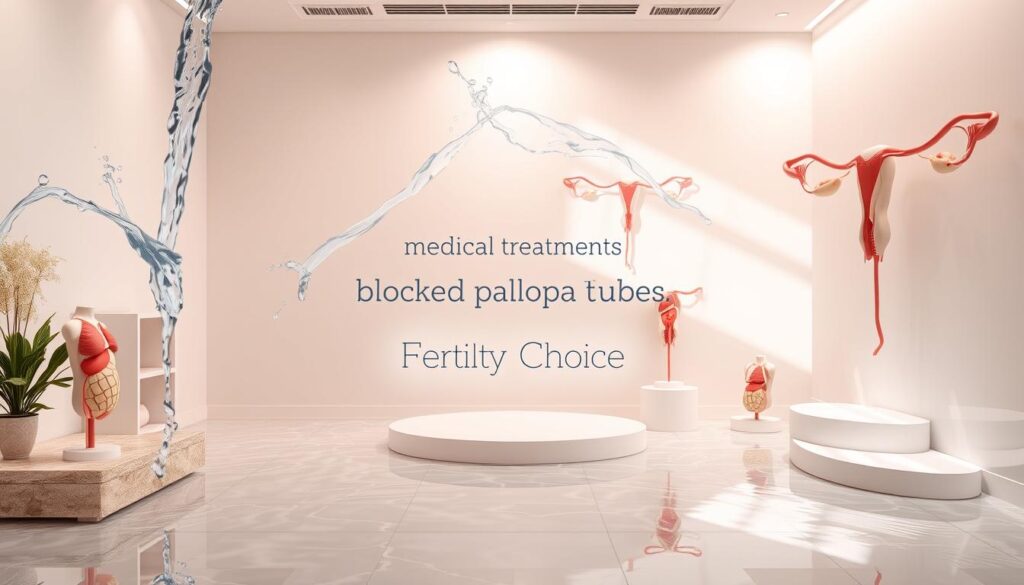
Endometriosis is a chronic condition that affects millions of women worldwide. It causes pain, infertility, and other symptoms. About 5.5 million women in North America have endometriosis1. It’s vital to seek treatment to manage symptoms and improve life quality through endometriosis care and managing symptoms.
Blocked fallopian tubes cause about 25-30% of infertility cases in women2. Problems with the fallopian tubes are a big part of infertility cases1. This shows how important it is to address this issue for women seeking treatment for endometriosis and care to boost their chances of getting pregnant.
Endometriosis is a top cause of infertility in women1. It can lead to tubal obstruction, affecting about 10% of women of reproductive age2. It’s crucial to provide effective treatment for endometriosis and managing symptoms to prevent further issues.
Fallopian tubes are key in reproduction, acting as a path for the egg to move from the ovary to the uterus3. After fertilization, an egg stays in the Fallopian tube for about 48-72 hours3. Damage or blockage in these tubes can cause infertility and issues like endometriosis, affecting around 10% of women of reproductive age worldwide4.
For women with endometriosis, finding the right medical options for endometriosis and holistic treatment for endometriosis is crucial. Endometriosis can block or damage the fallopian tubes, leading to infertility and other symptoms4. It’s vital to grasp the role of fallopian tubes in reproduction to understand how endometriosis affects fertility.
Fallopian tubes are essential for fertility, and their function must be maintained. Blockages in one tube can limit chances of getting pregnant, as ovulation in the other ovary is missed each cycle3.
Fallopian tubes are about 12 centimetres long3. Fertilization must happen within 24-72 hours after ovulation3. Knowing how fallopian tubes work is key to understanding the effects of endometriosis on fertility. It also highlights the need for medical options for endometriosis and holistic treatment for endometriosis.
Blocked fallopian tubes can happen for many reasons. These include infections, endometriosis, and past surgeries5. The Endometriosis Guide says endometriosis is a big reason for blocked tubes. It leads to infertility and other issues5.
This condition makes endometrial tissue grow outside the uterus. This causes inflammation and scarring. These can block the fallopian tubes.
Surgical procedures for endometriosis can help diagnose and treat blocked tubes5. These surgeries can also help with endometriosis pain relief. They can improve chances of getting pregnant. It’s key to see a doctor if symptoms don’t go away. Early treatment can greatly increase the chance of a successful pregnancy6.
Some common reasons for blocked fallopian tubes include:
Pelvic Inflammatory Disease (PID) is a serious health issue. It can block and damage the fallopian tubes, leading to infertility and other symptoms7. The South African Guideline for the Treatment of Endometriosis notes that PID can raise the risk of endometriosis. Natural remedies, like diet changes and stress management, can help manage PID and endometriosis symptoms.
Hormonal therapy, like birth control pills, is also used to treat endometriosis symptoms8. It’s crucial to know the causes and symptoms of PID to avoid long-term damage to reproductive organs. PID is often caused by bacterial infections, such as chlamydia and gonorrhea. Safe sex practices and regular check-ups can help prevent it9.
Some important facts about PID include:

Endometriosis is a chronic condition that affects millions of women worldwide. It causes pain, infertility, and other symptoms10. The growth of endometrial tissue outside the uterus can lead to inflammation and scarring. This causes blockages and damage to the fallopian tubes.
Women with endometriosis may experience severe pain during periods, heavy bleeding, and infertility11. Treatment for endometriosis includes medical therapy, surgical procedures, and lifestyle changes. It’s crucial for managing symptoms and improving quality of life.
Several factors contribute to the development of endometriosis. These include family history, short menstrual cycles, heavy and long menstrual periods, and hormonal imbalance.
It’s important to seek medical attention if symptoms persist. Early diagnosis and treatment can significantly improve endometriosis care and treatment for endometriosis10.
Understanding the causes and symptoms of endometriosis helps women manage their condition. With the right treatment and care, women can reduce symptoms and improve their quality of life11.
| Symptoms of Endometriosis | Description |
|---|---|
| Severe pain during periods | Pelvic pain, cramping, and heavy bleeding |
| Infertility | Difficulty getting pregnant due to blocked fallopian tubes |
| Heavy and long menstrual periods | Prolonged and heavy bleeding during menstruation |
Previous surgeries can cause adhesions and blockages in the fallopian tubes. This can lead to infertility and other symptoms12. Adhesions are bands of tissue that can form between organs or between an organ and the abdomen’s wall. It’s important to manage endometriosis symptoms to reduce the risk of these issues.
The South African Guideline for the Treatment of Endometriosis states that previous surgeries can cause adhesions and blockages in the fallopian tubes.
Hormone therapy can help slow the growth of endometrial tissue and new adhesion formation13. But, it may not remove existing scar tissue. Surgery to remove adhesions during a laparoscopy is recommended for those with significant pain. It’s crucial to weigh the risks and benefits of each medical option and discuss them with a healthcare provider.
Some key points to consider about adhesions and previous surgeries include:
The prevalence of endometriosis among fertile women ranges from 0.5% to 5%14. The peak incidence of endometriosis occurs between the ages of 30 and 45 years14. By understanding the risks and benefits of each medical option for endometriosis, individuals can make informed decisions about their treatment.
Congenital abnormalities are present at birth and can affect the female reproductive organs, including the fallopian tubes15. These can cause blockages and damage, leading to infertility and symptoms. The Endometriosis Guide states that these abnormalities can block and damage the fallopian tubes15.
Examples of these abnormalities include unicornuate uterus and rudimentary horn16. Women with these may experience pelvic pain and heavy menstrual bleeding. Holistic treatments like dietary changes and stress management can help manage symptoms. Surgical procedures, such as laparoscopy, can diagnose and treat blockages and damage16.
Treatment for congenital abnormalities varies and may include holistic treatments and surgery15. It’s crucial to get medical advice from a healthcare provider to find the best treatment. Sometimes, surgery is needed to repair or remove damaged tubes. Other times, holistic treatments can manage symptoms16.
In conclusion, congenital abnormalities can significantly affect the fallopian tubes, leading to infertility and symptoms. Seeking medical advice and exploring holistic and surgical treatments can help manage symptoms and improve reproductive health1516.
Blocked fallopian tubes can be caused by many things, like lifestyle choices and past health issues17. Smoking and being overweight can raise your risk. So can past surgeries or infections18. Knowing these risks helps you prevent them and get help when needed.
Some main risks for blocked fallopian tubes are:
Women with endometriosis pain can find relief with natural remedies18. These, along with a healthy lifestyle, can lower the risk of blocked tubes and boost reproductive health.
By knowing the risks and taking action, women can lower their chance of blocked tubes and better their chances of getting pregnant17. It’s key to talk to a healthcare expert for advice and treatment, if you have endometriosis pain or other symptoms18.
It’s hard to spot blocked fallopian tubes early, but it’s key for treatment. The Endometriosis Guide says early spotting is vital for treating blocked tubes1. Doctors use laparoscopy, hysterosalpingography, and ultrasound to find blockages or damage. These can be caused by endometriosis or pelvic inflammatory disease.
For endometriosis, doctors might use hormonal therapy or pain meds. Surgery can also help, like removing scar tissue or adhesions. Laparoscopy and hysterosalpingography are used to see and fix blockages in the tubes19.
Spotting and treating blocked fallopian tubes early can boost fertility and ease symptoms. With the right treatment, women can increase their chances of pregnancy. Medical options for endometriosis can also manage the condition and improve health1.
Blocked Fallopian tubes can be treated in different ways. This includes surgery for endometriosis and holistic treatments20. The right treatment depends on how bad the blockage is and the person’s health. Surgery, like laparoscopy, can help diagnose and fix the problem20. Fertility treatments, like IVF, can also help women with blocked tubes get pregnant21.
Some women might find holistic treatments helpful. These can include changing what you eat, managing stress, and other lifestyle changes22. Sometimes, a mix of surgery and holistic treatments is suggested21. It’s important to talk to a doctor to find the best treatment for blocked Fallopian tubes.
Here are some ways to treat blocked Fallopian tubes:

Blocked fallopian tubes can deeply affect women, causing feelings of infertility and loss23. It’s vital to manage endometriosis symptoms to lessen emotional pain. The Endometriosis Guide states that about 10% of women of childbearing age have endometriosis23. Natural remedies, like diet changes and stress management, can help ease symptoms.
Dealing with infertility is tough, but getting support is key. You can find help from family, friends, and healthcare providers. Here are some ways to cope:
Remember, infertility doesn’t define your worth or identity. By getting support and trying natural remedies, you can manage symptoms and feel better24.
You’re not alone in this journey. There are resources to help you deal with the emotional impact of blocked tubes and manage endometriosis symptoms25.
| Condition | Prevalence | Symptoms |
|---|---|---|
| Endometriosis | Approximately 10% of women of childbearing age23 | Pelvic pain, heavy bleeding, infertility |
| Blocked Fallopian Tubes | 30%-40% of infertility in women24 | Infertility, pelvic pain, abnormal bleeding |
Blocked fallopian tubes can be a big problem, but there are ways to lower the risk. Keeping a healthy weight, exercising often, and not smoking are key steps. These actions can help avoid fallopian tube issues26.
Seeing a doctor early if symptoms get worse is also important. This can lead to quick diagnosis and treatment. It might also prevent long-term problems26.
Healthy habits can protect your fallopian tubes and fertility26. Regular pelvic checks, treating infections quickly, and eating well are all good. They help keep your fallopian tubes healthy26.
Stress-reducing activities like yoga or meditation can also help. They can lessen the effects of conditions like endometriosis. This can prevent blockages in the fallopian tubes27.
If you have ongoing pelvic pain, unusual bleeding, or other health worries, see a doctor fast27. Early treatment of problems like pelvic inflammatory disease or endometriosis is vital. It can stop fallopian tube blockages and fertility issues26.
Working with your healthcare team is crucial. They can help you stay healthy and deal with any problems that come up28.
Stay Connected and Get Personalized Assistance
Thank you for reading! We hope you found this post helpful and informative. If you have any questions or need further assistance, please reach out. We’re here to help you on your journey
